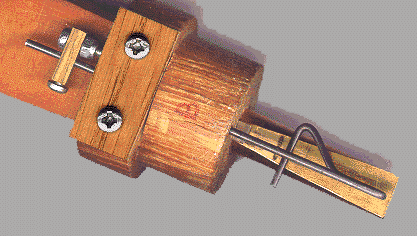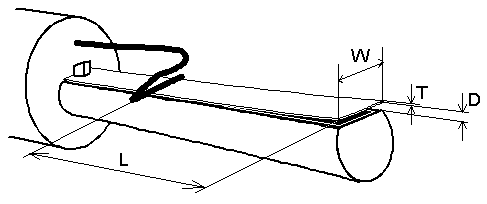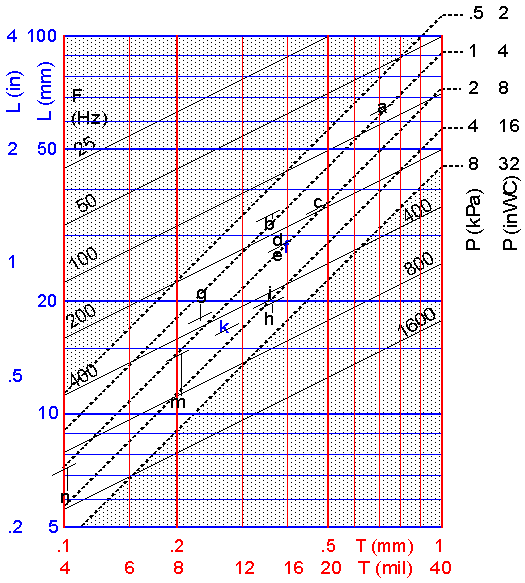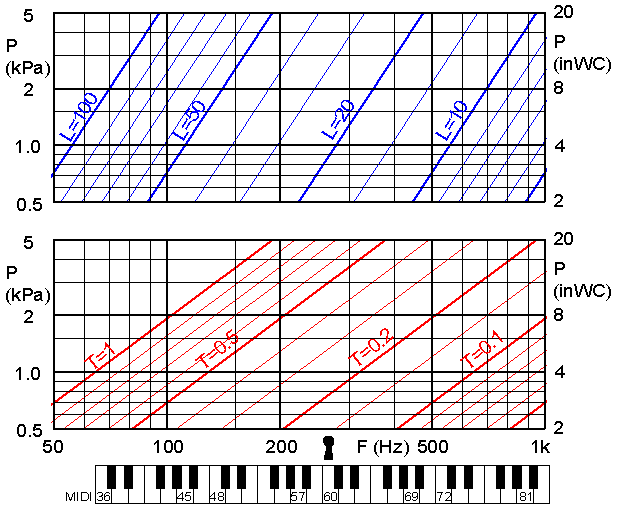| You Are Not Logged In | Login/Get New Account |
|
Please Log In. Accounts are free!
Logged In users are granted additional features including a more current version of the Archives and a simplified process for submitting articles. |
|
MMD
 Tech
Tech
 reedPipeDimensions
reedPipeDimensions
|
|
Spring Fundraising Drive In Progress. Please visit our home page to see this and other announcements:
https://www.mmdigest.com Thank you. --Jody
|
|
by Johan Liljencrants (MMD 010125)
Preface I think one spirit in a scientist is to explain with a formula what everybody else already knows. So, planning to finally make a few reed pipe ranks, I spent some time trying to find out if there is any theoretical basis for how big a reed pipe tongue should be. Indeed, you can set up two different criteria, one for the tongue resonance frequency, and one for the balance between tongue stiffness and blowing pressure. Combining these criteria leads to unique solutions for tongue length and thickness. An interesting side benefit is guidance on how to modify the dimensions should you make the tongue from different materials than conventional. For instance, if you make it from bamboo rather than brass it will have to be much longer and thicker because this is a very light material, yet still quite stiff. Keeping a similar shape leads to louder sound. Johan Liljencrants
Design dimensions for a reed pipe
tongue
This is about a number of proportionalities relevant as a guide to the dimensioning of a reed pipe tongue. The underlying theory is from basic physical laws that can be used to find proportionalities. Supplementing empirical data establish approximate values for the proportionality constants.
Assume the tongue to be a rectangular plate of thickness T, width W, and free oscillating length L. The material in the tongue has a density R and a Young's modulus E. We propose to blow it with an air pressure P and then want it to oscillate at a frequency F. The tongue volume and the material density render the mass of the oscillating part of the tongue M = (const)*T*W*L*R [meter^3*kilograms/meter^3 = kilograms]. The effective mass that will actually oscillate is smaller than volume times density. The tip of the tongue will contribute fully, but the fixed end not. We need not go into the theoretical details of this, or for instance whether the deformation shape of the tongue is circular, parabolic, or whatever. Instead we assume that this deformation shape is always the same, proportionately scaled to the tongue dimensions and its momentary deflection. Then the effective oscillating mass is always a fixed fraction of the total mass and we can eventually find out empirically how big the constant is. Applying the wind pressure will impose a force G on the flat surface of the tongue: G = W*L*P [meter^2 * newton/meter^2 = newton] and this will cause a certain tongue tip deflection D [meter]. Arbitrarily we can assign a nominal value for D equal to the gap at rest between tongue and shallot at the tip. This is not necessarily the same as the actual static deflection under pressure - any deviation from this will be included in the empirical proportionality constants later. From the theory of bending beams we can find a general connection between force and deflection, namely the stiffness K = G/D = (const)*E*W*(T/L)^3 [newton/meter] Again we need not bother about the constant, but note that stiffness increases in proportion to the material property E and to the width W of the tongue. Increasing thickness T or decreasing length L will increase stiffness very considerably because these are both raised to the third power. Combining the mass and stiffness expressions we arrive at a formula for the resonance frequency of the tongue F = sqrt(K/M)/(2*pi) = (const)*sqrt(E/R)*T/L^2 [hertz] The material specific quantity sqrt(E/R) is actually the speed of sound travelling along a bar and differs fairly little between those materials that can come in question. For brass it is about 3500, steel 5000, and aluminium 5100 meters/second. The temper state of the material, hard hammered or soft annealed, has a negligible influence on the frequency but is obviously important for the tongue to stay in shape under more severe mechanical stress, for instance during assembly. This formula for frequency is one foundation to select thickness and length for the tongue, it tells a relation between them but gives no absolute measure. For instance making a tongue twice as long and four times thicker will keep the same resonance frequency. But where to start? Let us postulate that when we apply the blowing pressure P, then the deflection D shall always be proportional to the length L. In other words, apart from magnitude scale, the shape of the tongue is always to be the same. Then we get from the G and K expressions, inserting D=(const)*L, that G/D = (const)*W*L*P/L = (const)*E*W*(T/L)^3
[newton/meter]
P = (const)*E*(T/L)^3 [pascal] Here we have a second foundation, a different relation between T and L as compared to that of the frequency formula. This one tells us that for a given pressure P there is a rather critical requirement on the ratio T/L. It is raised to the third power meaning that if we for instance keep L and make T twice as thick, then the pressure must be increased 8 times (while the frequency F will then increase to only twice the original). The implications of these formulas are condensed in fig 2. Its axes are for thickness T horizontally and length L vertically, both on logarithmic scales. The frequency formula is represented by a set of moderately sloping lines having constant T/L^2, marked with frequency in Hertz. The pressure formula gives the dashed lines at 45 degrees angle. The slopes and the mutual distances in these sets of lines are direct consequences of the formulas. Remains their absolute positions, the specific values of the proportionality constants - this is where the empirical data enters. Towards absolute numbersI have collected measurements of F, L, and T for some diverse conical and cylindrical reed pipes, home made over the times, and spanning over a sizable frequency range, table 1.
For each the L and T coordinates are marked with its designator in fig 2, and this is joined to a little oblique bar telling what frequency actually resulted. The (vertical) location of the set of frequency lines has been adapted to match these data as well as reasonably possible - ideally the bars and letters should coincide. All those pipes were meant to be blown at 2 kPa (8 in WC) pressure, hence the positioning of the pressure line set. One of the tongues is steel, one duralumin, the others brass, three of them moderately wider at the tip, but neither distinguish themselves notably in the diagram.
Naturally the empirical data points do not match the frequency and pressure lines perfectly, but their clustering close to the 2 kPa diagonal can be taken as a fair verification of the theoretical expectations. One observation in the diagram is that for a requested frequency and pressure you can use only a very limited range of tongue length and thickness, in practice you will probably have to stay within the white diagonal area. Judging from the pressure lines it is obvious that if you make the tongue too long as to enter the upper shaded area then the tongue may close and stay shut. In the lower shaded area the tongue is too stiff such that the air pressure is not enough to agitate it. It should be noted that the measurement of length L is basically very uncertain. Nominally this is from the tip of the tongue to the tuning wire, but the length that is effective in a particular case depends very much on the precise curve the voicer has succeeded to give the tongue. There are a number of other factors that also have their influence on the reed behaviour. Additional to the tongue material there is for instance whether the shallot is leathered or not, or if the width of the tongue varies somewhat lengthwise, if D is in proportion, and the frequency pulling effect from the pipe resonator. It appears that all those factors can be grossly neglected, they typically may modify the tongue frequency several semitones from the diagram prediction. This is however overshadowed and easily compensated for by even a moderate change in length, which as said is anyway critically dependent on tongue curvature. From requirements to dimensionsUsing the frequency and pressure proportionalities above you can manipulate them into solutions for length and thickness that would be appropriate for specified frequency and pressure L = (const)*E^( 1/6)*R^(-1/2)*P^(1/3)*F^(-1)
These are shown in fig 3, maybe this representation is easier to use in a design situation.
Example: For a tongue to oscillate at 200 Hz at 2 kPa pressure its length L should be 37 mm and thickness T 0.5 mm. Other tongue materialsThe diagram of fig 3 is for brass material in the tongue. Using the E and R factors in the L and T equations you can compute rescalings for other materials, as shown in table 2.
Table 2. Material properties. For materials other than brass,
For steel you should multiply L by 1.17 and T by 0.94, close enough to unity you may neglect it. For aluminium, multiply L by 1.66 and T by 1.90. Assuming constant shape this would also imply a larger D such that supply as well as acoustic power should more than double when switching to an aluminium tongue. Experiment showed this is indeed true, item f in tab1 sounds about 5 dB stronger than e. But there is no sound level difference between d and f, d being identically the same tongue as e, but with a different curve. Bamboo and spruce are materials with an extreme ratio between E and R, comparable only to carbon fiber composites. Even if they are no serious candidates for an organ pipe tongue the table illustrates their potential for high sound level. And that there is a reason you do not use metal reeds in the orchestra woodwinds.
22 January 2001, revised 25 January 2001 |
|
|
|
|
|
|
|
|
|
CONTACT FORM: Click HERE to write to the editor, or to post a message about Mechanical Musical Instruments to the MMD Unless otherwise noted, all opinions are those of the individual authors and may not represent those of the editors. Compilation copyright 1995-2024 by Jody Kravitz. Please read our Republication Policy before copying information from or creating links to this web site. Click HERE to contact the webmaster regarding problems with the website. |
|
|
||||||
|



